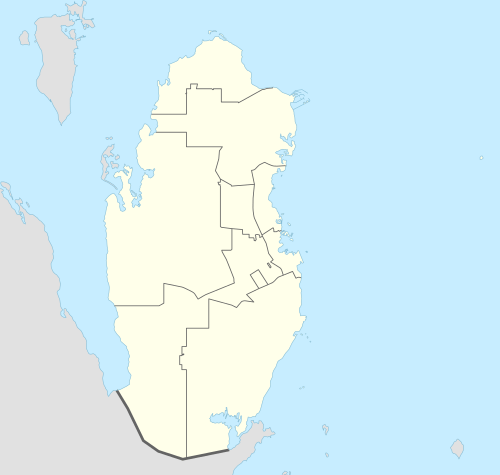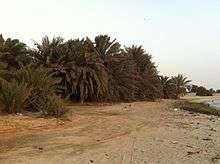Umm Bab
| Umm Bab أم باب | |
|---|---|
| Settlement | |
 Umm Bab | |
| Coordinates: QA 25°12′35″N 50°48′48″E / 25.20972°N 50.81333°ECoordinates: QA 25°12′35″N 50°48′48″E / 25.20972°N 50.81333°E | |
| Country | Qatar |
| Municipality | Al Rayyan |
| Area | |
| • Total | 495.2 km2 (191.2 sq mi) |
| Population | |
| • Total | 6,194 |
| • Density | 13/km2 (32/sq mi) |
Umm Bab is a settlement in Qatar, located in the municipality of Al Rayyan.[1] It used to be part of the Al Jemailya municipality before the municipality was incorporated into Al Rayyan.[2] Umm Bab is also known as 'Palm Tree Beach' owing to a small cluster of palm trees situated on its beach.[3]
The settlement derived its name from local geographical features. Umm Bab translates to 'mother of gateway'. The 'gateway' portion of the name refers to a narrow path or opening in the area surrounded by two small hills which resemble a gateway.[4]
History

In 1948, shortly after the commencement of oil drilling operations in Dukhan, a housing village was built to the immediate south of Umm Bab to accommodate both Qatar Petroleum workers and locals of Umm Bab.[5] A road was built the same year to connect Umm Bab and Dukhan.[6] In 1961, the government inaugurated a boys school in the village. The housing village had approximately 50 houses by 1990, most of which belonged to members of the Al Murrah tribe who were employed by Qatar Petroleum.[5]
Industry
Umm Bab is one of only two sites in Qatar from which large quantities of limestone and clay can be easily excavated, the other site being Umm Salal.[7] In 1965, the government capitalized on Umm Bab's rich natural resources by headquartering the Qatar National Cement Company in the area.[8] This decision also served as an impetus to develop Qatar's western region.[7]
The first processing of cement took place in 1969, and the factory received its water supply from Rawdat Rashed and its oil supply from Dukhan.[9]
Demographics
As of the 2010 census, the settlement comprised 220 housing units[10] and 55 establishments.[11] There were 6,194 people living in the settlement, of which 97% were male and 3% were female. Out of the 6,194 inhabitants, 97% were 20 years of age or older and 3% were under the age of 20.[12] The literacy rate was 96.4%.
Employed persons made up 96% of the total population. Females accounted for 1% of the working population, while males accounted for 99% of the working population.[12]
| Year | Population |
|---|---|
| 1986[13] | 1,036 |
| 1997[14] | 1,829 |
| 2004[2] | 1,287 |
| 2010[1] | 6,194 |
References
- 1 2 "2010 population census" (PDF). Qatar Statistics Authority. Retrieved 29 June 2015.
- 1 2 "2004 population census". Qatar Statistics Authority. Retrieved 1 July 2015.
- ↑ "Beaches". Qatar Tourism Authority. Retrieved 1 July 2015.
- ↑ Jacques LeBlanc (March 2008). "A fossil hunting guide to the tertiary formations of Qatar, Middle East".
- 1 2 Fahd Abdul Rahmn Hamad Al-Thani (1992). "The Spatial Impact of the Hydrocarbon Industry on Land and Sea Use in Qatar" (PDF). University of Durham; Durham e-Thesis. p. 148.
- ↑ Fahd Abdul Rahmn Hamad Al-Thani (1992). "The Spatial Impact of the Hydrocarbon Industry on Land and Sea Use in Qatar" (PDF). University of Durham; Durham e-Thesis. p. 138.
- 1 2 Al-Kubaisi, Mohammed Ali M. (1984). Industrial development in Qatar: a geographical assessment (PDF). Durham E-Theses, Durham University. p. 151.
- ↑ "About the company" (in Arabic). Qatar National Cement Company. Retrieved 29 July 2015.
- ↑ Al-Kubaisi, Mohammed Ali M. (1984). Industrial development in Qatar: a geographical assessment (PDF). Durham E-Theses, Durham University. p. 152.
- ↑ "Housing units, by type of unit and zone (April 2010)" (PDF). Qatar Statistics Authority. Retrieved 7 August 2015.
- ↑ "Establishments by status of establishment and zone (April 2010)" (PDF). Qatar Statistics Authority. Retrieved 7 August 2015.
- 1 2 "Geo Statistics Application". Ministry of Development Planning and Statistics. Retrieved 7 August 2015.
- ↑ "1986 population census" (PDF). Qatar Statistics Authority. Retrieved 2 July 2015.
- ↑ "1997 population census" (PDF). Qatar Statistics Authority. Retrieved 2 July 2015.
